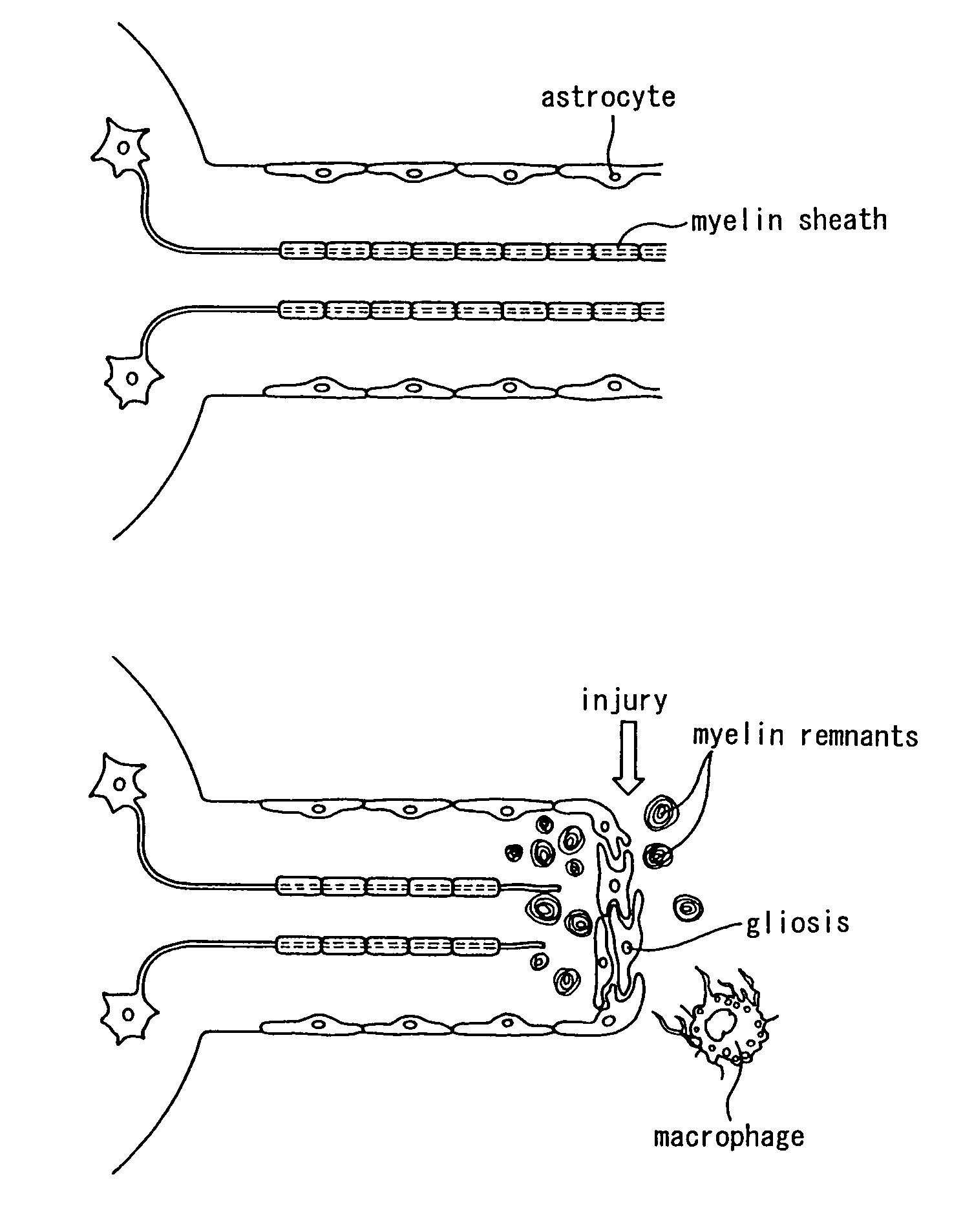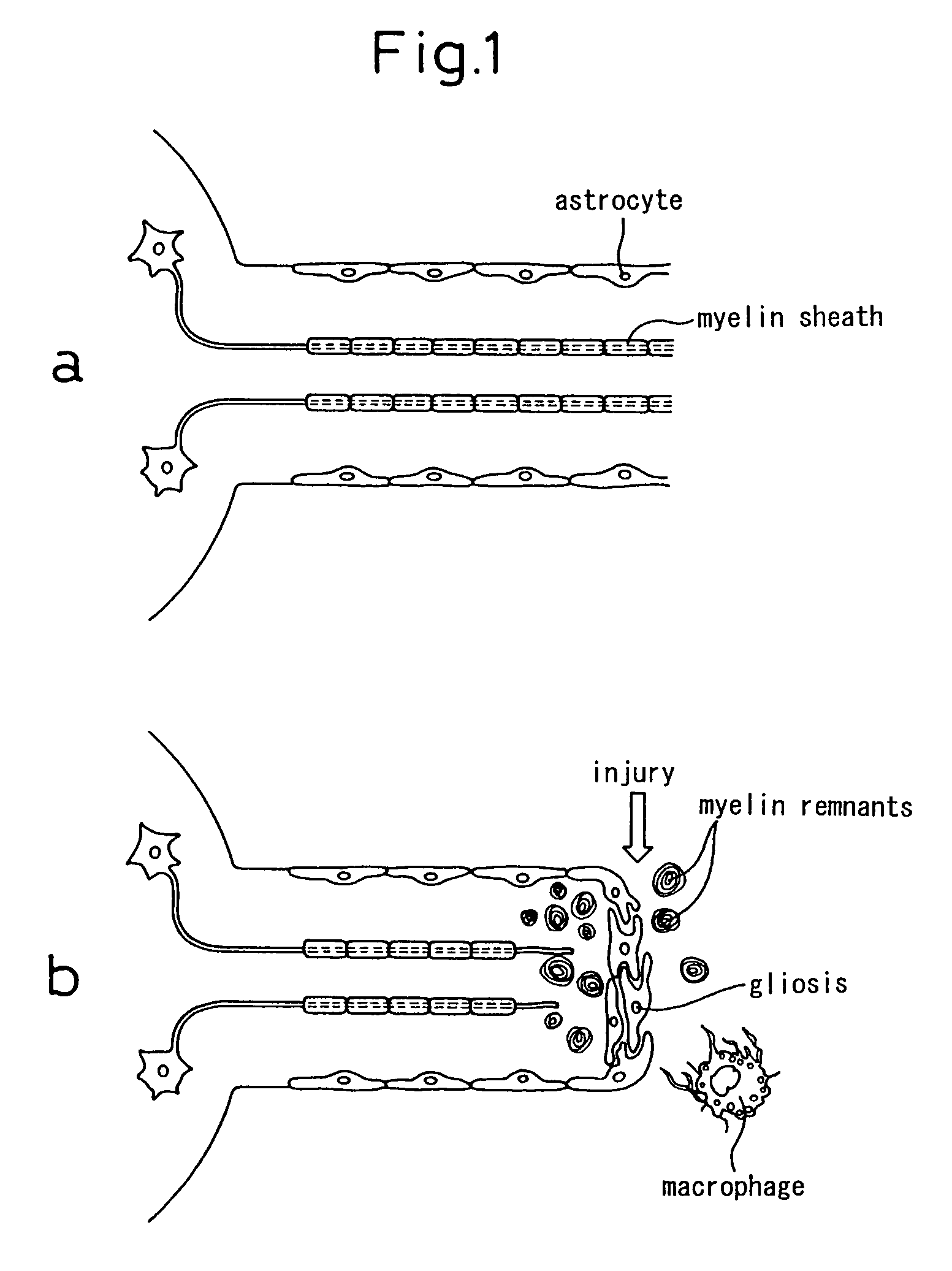Schwann cells originating in myeloid interstitial cells
a technology of myeloid interstitial cells and schwann cells, which is applied in the field of schwann cells originating in myeloid interstitial cells, can solve the problems of delayed processing of residues in the early stages, considered disadvantageous regeneration, and process degeneration, and achieves high proliferation potency, easy extraction, and large-scale culturing
- Summary
- Abstract
- Description
- Claims
- Application Information
AI Technical Summary
Benefits of technology
Problems solved by technology
Method used
Image
Examples
example 1
Induced Differentiation of Bone Marrow Stromal Cells to Bone Marrow Stromal Cell-Derived Schwann Cells
[0096]FIG. 11 is a flow chart summary of the treatment process for inducing differentiation.
[0097]Stromal cells were extracted from the bone marrow of adult rats (wistar rats) and cultured. The culture medium used was Minimum Essential Medium Eagle Alpha Modification supplemented with 20% fetal calf serum. After subculturing to four generations to reach 50% confluency, β-mercaptoethanol was added to a 1 mM concentration to the culture solution for a period of 24 hours. The medium was then exchanged with medium containing 35 ng / ml retinoic acid. The latter culture medium was also Minimum Essential Medium Eagle Alpha Modification supplemented with 20% fetal calf serum. After 3 days, the culture medium was again exchanged with medium containing 5 μM forskolin, 5 ng / ml platelet-derived growth factor-AA, 10 ng / ml basic fibroblast growth factor and 200 ng / ml Heregulin™. The cells were imm...
example 2
Regeneration of Central Nerve (Severed Optic Nerve)
[0098]The cells obtained in Example 1 were collected by trypsin treatment and combined with mouse EHS tumor-derived Matrigel extracellular matrix (40234A, Collaborative Biomedical Products), and were then transplanted after being packed into artificial tubes (HIP10–43 Hollow fiber cartridge, Amicon) which were then sutured to severed optic nerves (central nervous system) of adult rats (Wistar).
[0099]FIG. 12 shows the results with GAP43 (Growth Associated Protein-43, a protein expressed during growth and elongation of nerve fibers) labeling, 10 days after transplantation. The white arrows indicate the graft origins and the black arrows indicated the regenerating fiber tips. Significant elongation of nerve fibers is seen with the differentiation-induced bone marrow stromal cells (right) compared to the untreated bone marrow stromal cells (left). The nerve fiber elongation distance and number of fibers increased with the number of week...
example 3
Regeneration of Peripheral Nerve (Sciatic Nerve)
[0101]The sciatic nerves of adult rats (Wistar rats) were severed and inoculated with artificial tubes packed with differentiation-induced bone marrow stromal cells.
[0102]FIG. 14 shows the results with GAP43 (Growth Associated Protein-43) labeling, 7 days after transplantation. The white arrows indicate the graft origins and the black arrows indicate the regenerating fiber tips. The nerve fibers are seen to be elongated with the differentiation-induced bone marrow stromal cells (right) compared to the Matrigel (extracellular matrix) alone (left). The nerve fiber elongation distance and number of fibers increased with the number of weeks.
[0103]The results at the fourth week after grafting are shown in FIG. 15. Here, GFP (Green Fluorescent Protein) shown in grey represents the bone marrow stromal cells illuminated by introducing the green fluorescent protein gene (GFP) using a retrovirus, MAG shown in dots represents myelin protein, and ...
PUM
| Property | Measurement | Unit |
|---|---|---|
| time | aaaaa | aaaaa |
| time | aaaaa | aaaaa |
| concentration | aaaaa | aaaaa |
Abstract
Description
Claims
Application Information
 Login to View More
Login to View More - R&D
- Intellectual Property
- Life Sciences
- Materials
- Tech Scout
- Unparalleled Data Quality
- Higher Quality Content
- 60% Fewer Hallucinations
Browse by: Latest US Patents, China's latest patents, Technical Efficacy Thesaurus, Application Domain, Technology Topic, Popular Technical Reports.
© 2025 PatSnap. All rights reserved.Legal|Privacy policy|Modern Slavery Act Transparency Statement|Sitemap|About US| Contact US: help@patsnap.com



